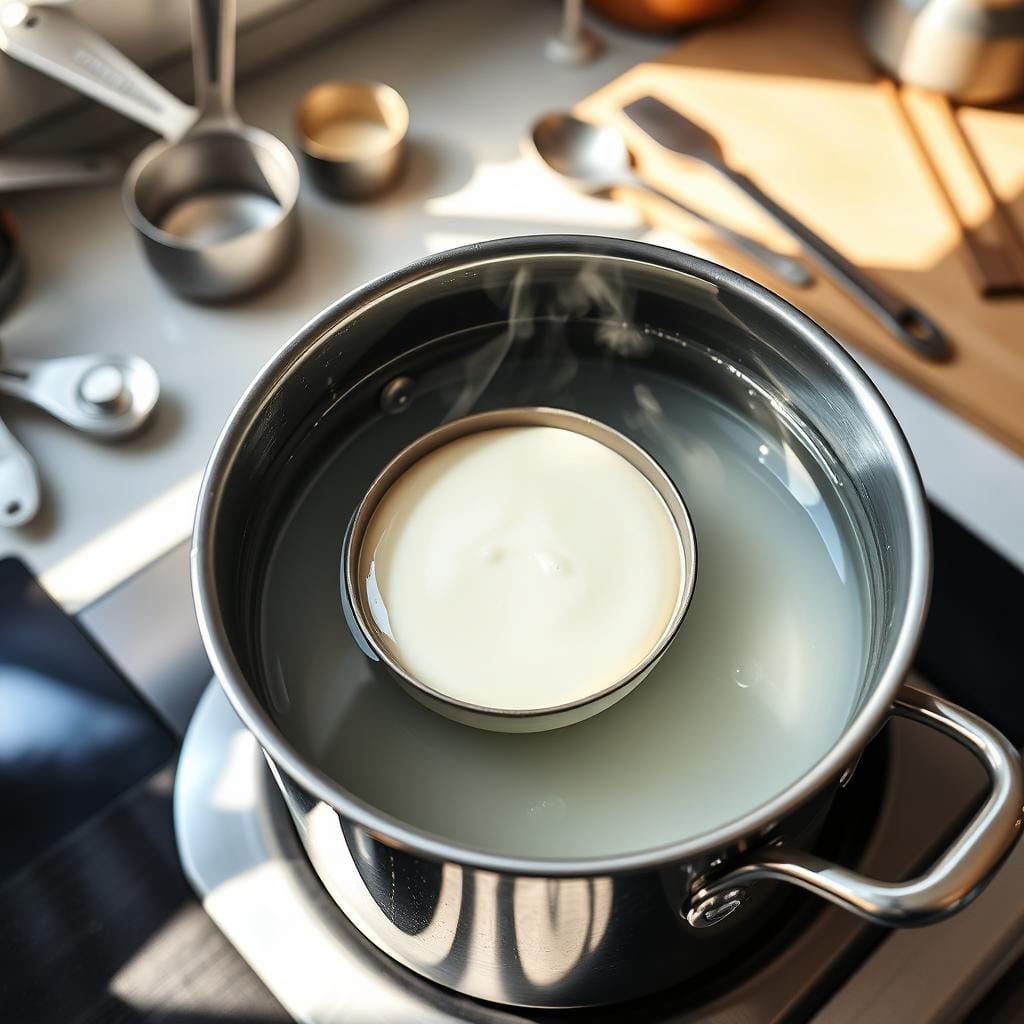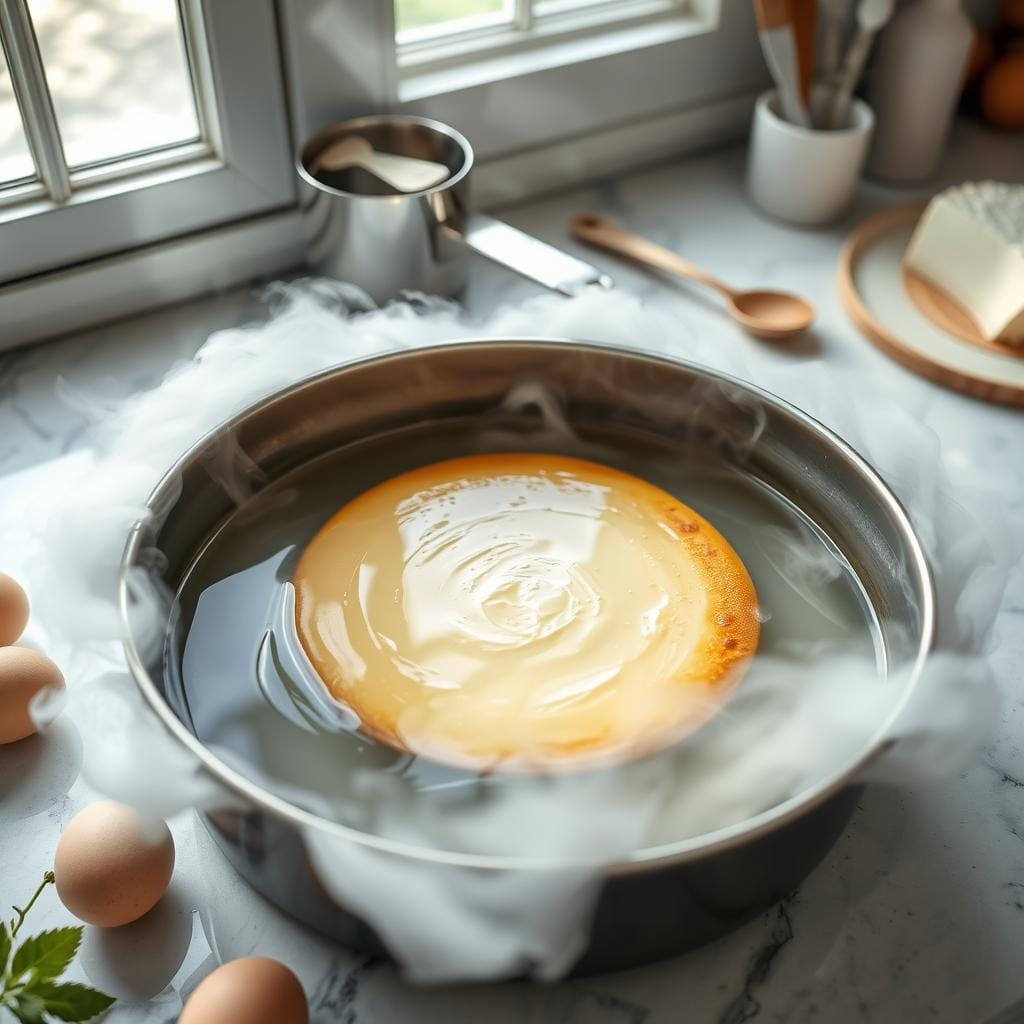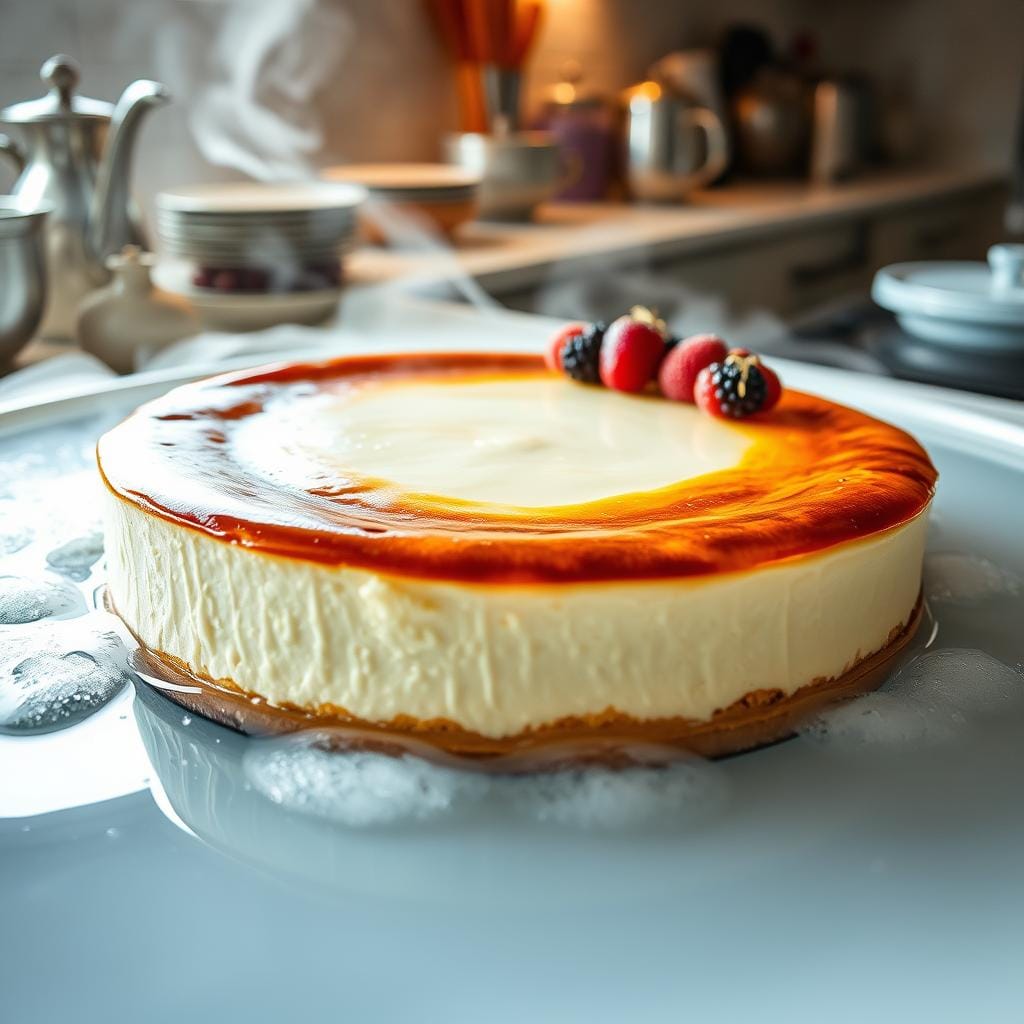Ever wondered why chefs and bakers love the water bath (or bain-marie) for cheesecake? This step can turn a cheesecake into a smooth, creamy delight or a dry, cracked mess. Learn how the water bath can make your cheesecake baking a success.

Key Takeaways
- The water bath, or bain-marie, is a crucial technique for baking creamy, crackless cheesecakes.
- It works by creating a humid, even cooking environment that prevents the cheesecake from drying out or cracking.
- Properly setting up and using a water bath can make all the difference in achieving the perfect cheesecake texture.
- Understanding the science behind the water bath technique can help you master this essential skill in cheesecake baking.
- Avoiding common mistakes when using a water bath is key to consistently delicious results.
Understanding the Basics of a Water Bath (Bain-Marie)
The bain-marie, or water bath, is a cooking method used for centuries. It helps control temperature and keep food moist. It comes from ancient Greece and Rome, used for cooking and science.
History of the Bain-Marie Technique
The term “bain-marie” comes from French, meaning “Mary’s bath.” Medieval alchemists used it for potions. Today, it’s key for making custards, crème brûlée, and cheesecakes.
Scientific Principles Behind Water Baths
Water baths regulate temperature and keep food moist. The water absorbs and spreads heat evenly. This prevents cracks and a dry texture in foods like cheesecakes.
They also keep the cheesecake’s top moist. This avoids a tough crust. So, the cheesecake turns out smooth and evenly-cooked.
| Benefit | Explanation |
|---|---|
| Temperature Control | The water bath maintains a steady, gentle heat. This prevents sudden changes that can cause problems. |
| Moisture Regulation | The water bath keeps the cheesecake’s top moist. This stops a tough crust from forming. |

“The water bath is a simple yet crucial technique that allows bakers to achieve the perfect texture and consistency in their cheesecakes.”
What is a Water Bath When Making Cheesecake?
Baking the perfect cheesecake often involves a water bath, also known as a bain-marie. This technique is loved by both professional chefs and home bakers. It involves placing the cheesecake pan in a larger pan filled with hot water. This creates a moist, gentle environment for the cake to bake.
The water bath ensures the cheesecake’s custard-like interior cooks evenly and slowly. This prevents it from cracking or becoming dry and dense. The water acts as a buffer, keeping the cheesecake at a consistent temperature. It stops the outer edges from overcooking while the center stays undercooked.
This cheesecake cooking method is key for custard-based desserts like cheesecake. It helps achieve a smooth, creamy, and indulgent texture. This is hard to get with traditional baking methods.
| Cheesecake Cooking Method | Texture Outcome |
|---|---|
| Water Bath | Smooth, creamy, and indulgent |
| Traditional Baking | Denser, drier, and more prone to cracking |
Understanding the benefits of a water bath in cheesecake baking can improve your skills. You can make a top-notch, restaurant-quality dessert right in your kitchen.

“The secret to the perfect cheesecake is all in the water bath. It’s the key to that rich, velvety texture everyone craves.”
Essential Equipment for the Perfect Water Bath Setup
Baking the perfect cheesecake needs the right tools, especially for a water bath. This method ensures your cheesecake is smooth, creamy, and crack-free. Let’s look at the key tools and materials for the ultimate water bath setup.
Recommended Pan Sizes and Types
The base of your water bath setup is the pan for your cheesecake. Springform pans are best because they make it easy to remove the cheesecake after baking. Choose a high-quality springform pan that’s oven-safe and 9 or 10 inches in diameter. This size helps with even baking and the right cheesecake texture.
Additional Tools and Materials
Along with the springform pan, you’ll need a few more items for your water bath:
- A large, deep roasting pan or oven-safe baking dish that’s at least 2 inches deeper than your springform pan
- Heavy-duty aluminum foil to wrap the springform pan and prevent water from seeping in
- A tea towel or oven mitts to safely handle the hot water bath
- A kettle or pot for boiling water
With these essential items, you’re ready to bake a cheesecake with the perfect texture. The water bath technique is key to achieving this.
Benefits of Using a Water Bath for Cheesecake
Baking cheesecake can be tricky, but a water bath makes it easier. It helps you get a crack-free cheesecake every time. The water bath method prevents cracking and keeps the cheesecake moist. It also makes sure the heat is spread out evenly.
One big plus of the water bath is it stops cracks on the cheesecake’s surface. The humid oven environment helps the cake bake slowly and evenly. This reduces the chance of sudden temperature changes that can cause cracks.
The water bath also makes the cheesecake bake evenly. This results in a smooth, creamy texture all the way through. This is key for that perfect moist cheesecake texture everyone loves.
“The water bath is a game-changer for achieving the perfect cheesecake every time. It’s a simple technique that makes a huge difference in the final result.”
Using a water bath also ensures the heat is spread uniformly across the cake. This prevents hot spots and uneven baking. It helps make a consistent texture and flavor, giving you a professional-looking cheesecake that will wow your guests.
The water bath has many benefits for baking cheesecake. It prevents cracks, keeps the cheesecake moist, and ensures even heat. By adding this simple technique to your baking, you can make your cheesecake look and taste like it came from a bakery.
Step-by-Step Guide to Preparing Your Water Bath
Making the perfect cheesecake needs precision. A water bath, or bain-marie, is key in the cheesecake baking technique. It helps control the temperature for a smooth, creamy texture.
Proper Wrapping Techniques
Start by wrapping your springform pan in heavy-duty aluminum foil. Use a double layer to keep water out during baking.
Water Temperature and Level Guidelines
- Fill a roasting pan or baking dish with hot water. Make sure it reaches halfway up your springform pan.
- Keep the water temperature between 325°F and 350°F. This even heat ensures your cheesecake bakes well.
Safety Precautions
- Wear oven mitts when handling the hot water bath to avoid burns.
- Be careful when taking the cheesecake out of the oven. The water bath is very hot.
- Let the water bath cool down completely before moving or emptying it.
By following these steps, you’ll get great at using a water bath. You’ll enjoy perfectly baked cheesecakes every time.
Common Mistakes to Avoid When Using a Water Bath
Getting the perfect cheesecake cooking methods is an art. Using a water bath is key to avoid common problems like cracking. But even skilled bakers can make mistakes. Let’s look at these errors and how to steer clear of them.
One big mistake is filling the water bath too much, which can cause leaks. Make sure the water level is below the springform pan’s top. You can also wrap the pan with aluminum foil or use a silicone cover to keep water out.
- Avoid over-filling the water bath, as this can cause leaks.
- Wrap the springform pan securely with aluminum foil or use a silicone cover to create a barrier.
- Ensure the water level stays below the top of the springform pan.
Another mistake is setting the wrong water bath temperature. The ideal temperature is around 325°F to 350°F. This range helps cook the cheesecake evenly and prevents cracks. Adjusting the oven or water temperature can greatly affect your cheesecake’s texture and look.
| Common Issue | Potential Cause | Solution |
|---|---|---|
| Leaky Water Bath | Overfilled water bath | Maintain water level below the springform pan |
| Cracked Cheesecake | Incorrect water temperature | Adjust oven and water temperature to 325°F – 350°F |
By being careful and avoiding these mistakes, you’ll make delicious cheesecakes. They’ll look great and taste amazing. Remember, paying attention to details is crucial for a perfect cheesecake every time.
“The key to a perfect cheesecake is in the preparation and attention to detail. Mastering the water bath technique is essential for preventing cracks and ensuring a smooth, creamy texture.”
Achieving the Perfect Texture: Water Bath vs. Traditional Method
Choosing the right method is key to a moist cheesecake. The traditional method and the water bath (bain-marie) technique each offer unique textures. These can change how your baked custard desserts feel and taste.
Texture Comparison
Cheesecakes baked in a water bath are silkier and creamier. The water bath’s gentle heat prevents cracks and gives a smooth feel. On the other hand, cheesecakes baked without water can be denser and firmer, which some might not like as much.
Moisture Content Analysis
The water bath keeps more moisture in the cheesecake, making it richer. It keeps the edges moist, ensuring the whole cheesecake stays moist. Cheesecakes baked without water might lose more moisture, becoming drier and less rich.
| Texture Characteristic | Water Bath Cheesecake | Traditional Cheesecake |
|---|---|---|
| Creaminess | Silky, velvety | Denser, firmer |
| Moisture Content | Consistently moist | Potentially drier |
| Susceptibility to Cracking | Less prone to cracking | More prone to cracking |
Whether to use a water bath or the traditional method depends on what you prefer. Both ways can make a delicious cheesecake. But, if you want a creamy, rich dessert, the water bath might be the better choice.
Troubleshooting Water Bath Issues
Mastering the cheesecake baking technique with a water bath is a big step. But, it comes with its own set of challenges. Leaks and texture problems are just a few things you might face. We’ll look at common issues and offer solutions to make your cheesecake perfect every time.
Preventing Cracking
Cracking is a big problem with water baths. It can happen due to overbaking, sudden temperature changes, or wrong pan wrapping. To avoid this, stick to the water bath’s temperature and timing. Also, try running a knife around the edges before taking it out of the oven.
Tackling Leaks
- Make sure your springform pan is sealed and waterproof before putting it in the water bath.
- Wrap the outside of the pan with heavy-duty aluminum foil, layering it for extra protection.
- Put the wrapped pan on a baking sheet to catch any leaks.
Addressing Underbaking and Overbaking
- Underbaked cheesecake: Bake it longer in the water bath, checking every 5-10 minutes.
- Overbaked cheesecake: Bake it for less time, and try lowering the oven temperature a bit.
By tackling these common problems, you’ll get better at making perfect cheesecakes. You’ll learn how to prevent cracking and enjoy delicious results every time.
Alternative Methods and When to Use Them
The traditional water bath method is popular for making smooth cheesecakes. But, there are other ways to get great results. These methods are good if you don’t want to set up a water bath or if your oven is small.
Steam Method Options
One alternative is the steam baking method. You place a pan of hot water on the oven’s bottom rack. This creates steam that cooks the cheesecake gently. It helps prevent cracks and makes the cheesecake creamy.
No-Bath Techniques
You can also skip the water bath. Some people wrap the springform pan in foil or bake it in a water-filled roasting pan. These methods are great if you’re short on time or oven space.
Choosing between water bath, steam baking, or no-bath methods depends on your preference and what you have. Try different methods to see which works best for your baked custard desserts and cheesecakes.
Conclusion
We’ve looked into the amazing benefits of using a water bath for baking cheesecake. By understanding the science and mastering the steps, you can improve your baking skills. Achieving a creamy, crack-free cheesecake is now possible with the water bath method.
The water bath provides a gentle, even heat. This ensures your cheesecake bakes slowly and evenly. It prevents cracking and gives a soft, silky texture, just like a professional bakery.
So, when you want a creamy, indulgent cheesecake, try the water bath technique. Your family and friends will be impressed by your skill in cheesecake baking technique. Enjoy the water bath benefits and elevate your dessert game.

